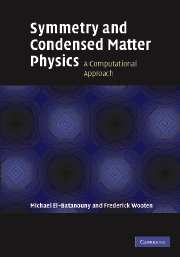Book contents
- Frontmatter
- Contents
- Preface
- 1 Symmetry and physics
- 2 Symmetry and group theory
- 3 Group representations: concepts
- 4 Group representations: formalism and methodology
- 5 Dixon's method for computing group characters
- 6 Group action and symmetry projection operators
- 7 Construction of the irreducible representations
- 8 Product groups and product representations
- 9 Induced representations
- 10 Crystallographic symmetry and space-groups
- 11 Space-groups: Irreps
- 12 Time-reversal symmetry: color groups and the Onsager relations
- 13 Tensors and tensor fields
- 14 Electronic properties of solids
- 15 Dynamical properties of molecules, solids, and surfaces
- 16 Experimental measurements and selection rules
- 17 Landau's theory of phase transitions
- 18 Incommensurate systems and quasi-crystals
- Bibliography
- References
- Index
1 - Symmetry and physics
Published online by Cambridge University Press: 06 July 2010
- Frontmatter
- Contents
- Preface
- 1 Symmetry and physics
- 2 Symmetry and group theory
- 3 Group representations: concepts
- 4 Group representations: formalism and methodology
- 5 Dixon's method for computing group characters
- 6 Group action and symmetry projection operators
- 7 Construction of the irreducible representations
- 8 Product groups and product representations
- 9 Induced representations
- 10 Crystallographic symmetry and space-groups
- 11 Space-groups: Irreps
- 12 Time-reversal symmetry: color groups and the Onsager relations
- 13 Tensors and tensor fields
- 14 Electronic properties of solids
- 15 Dynamical properties of molecules, solids, and surfaces
- 16 Experimental measurements and selection rules
- 17 Landau's theory of phase transitions
- 18 Incommensurate systems and quasi-crystals
- Bibliography
- References
- Index
Summary
Introduction
The application of group theory to study physical problems and their solutions provides a formal method for exploiting the simplifications made possible by the presence of symmetry. Often the symmetry that is readily apparent is the symmetry of the system/object of interest, such as the three-fold axial symmetry of an NH3 molecule. The symmetry exploited in actual analysis is the symmetry of the Hamiltonian. When alluding to symmetry we usually include geometrical, time-reversal symmetry, and symmetry associated with the exchange of identical particles.
Conservation laws of physics are rooted in the symmetries of the underlying space and time. The most common physical laws we are familiar with are actually manifestations of some universal symmetries. For example, the homogeneity and isotropy of space lead to the conservation of linear and angular momentum, respectively, while the homogeneity of time leads to the conservation of energy. Such laws have come to be known as universal conservation laws. As we will delineate in a later chapter, the relation between these classical symmetries and corresponding conserved quantities is beautifully cast in a theorem due to Emmy Noether.
At the day-to-day working level of the physicist dealing with quantum mechanics, the application of symmetry restrictions leads to familiar results, such as selection rules and characteristic transformations of eigenfunctions when acted upon by symmetry operations that leave the Hamiltonian of the system invariant.
- Type
- Chapter
- Information
- Symmetry and Condensed Matter PhysicsA Computational Approach, pp. 1 - 20Publisher: Cambridge University PressPrint publication year: 2008

